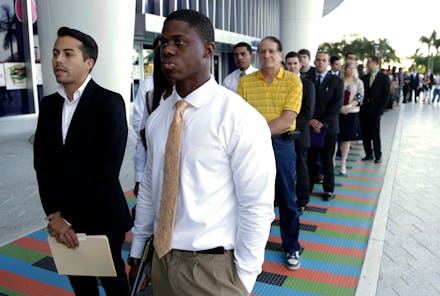Why the New Job Report is Bad News For Millennials

On Friday, the U.S. Bureau of Labor Statistics (BLS) released their October Employment Report. Taking into account the effects of the government shutdown, economists expected a net jobs gain between 100,000 and 120,000 and an unemployment rate rise to 7.3 or 7.4%.
The official report did indeed state that the unemployment rate rose to 7.3%; however, total nonfarm employment also increased by a whopping 204,000. Despite a relatively large number of jobs added last month and a large number leaving the labor force, which would typically lower the unemployment rate, the higher rate stems from furloughed federal employees being classified as unemployed on temporary layoff under the household survey’s definition.
Highlights of the report include: 204,000 net jobs were added; 2.3 million jobs total were added over the course of the last year, an average of 190,000 per month; 11.3 million people remain unemployed; the unemployment rate increased by 0.1% to 7.3%; the unemployment rate that includes the unemployed, underemployed, and discouraged workers rose to a frightening 13.8%; the employment-to-population rate for 25 to 54-year-olds declined to 75.5%; and the labor force participation rate fell to 62.8%.
A closer look at labor market factors for teenagers and young adults, however, shows dismal job prospects for 16 to 24 year olds.
Source: Federal Reserve Bank of St. Louis Economic Data
Young adults face an abysmal labor market with their employment-to-population rate and labor-force participation rate (both on the left axis) at lows not seen in 40 years and an unemployment rate (right axis) more than twice the national average. This steep decline in the demographic’s participation in the labor force and employment rate paired with and an unemployment rate of 15.1% clearly indicate that millennials are suffering.
Factors contributing to this age group’s job market woes are the implementation of Obamacare, minimum wage laws, and a host of other issues that decrease employers’ confidence in their future profitability, incentivizing them to let go of their least-skilled workers, who are typically younger.
The decline in teenagers and young adults' job outlook poses challenges for those who are attempting to launch their careers. As the number of young people unemployed and exiting the labor force increases, the opportunities these same young people will have to start their careers, learn from on-the-job training, and improve their future productivity—a key to their prosperity — decrease.
Millennials who bear the burdens of not having a job, having to pay for ObamaCare, and the rapid increases in college tuition are missing their chance to live the American Dream. This is a huge drain on the American economy — A trend that must be reversed soon if America wants to continue to be the beacon of hope for many of the world’s young adults.